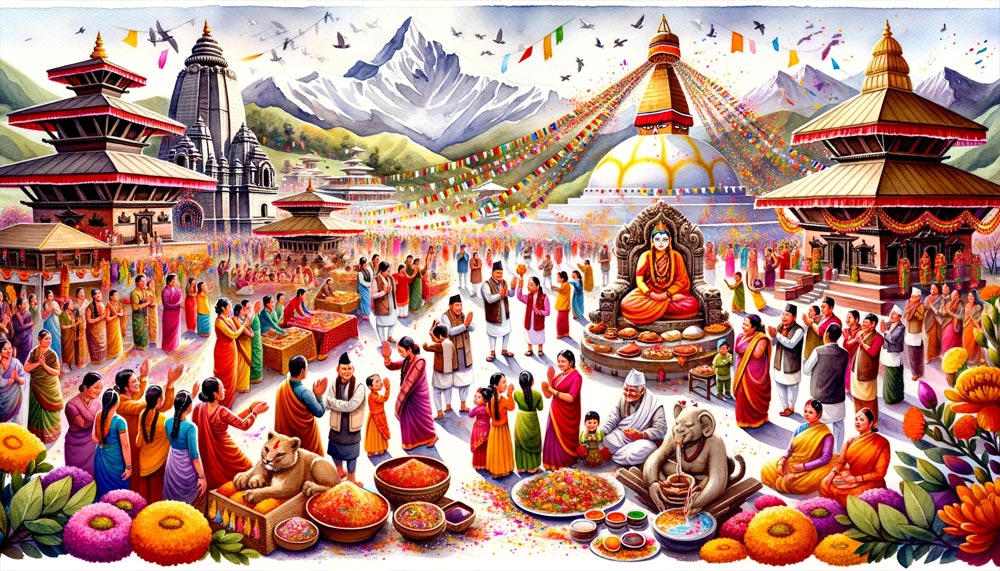
Family Traditions in Nepal: Benefits & Societal Impact
Introduction:
Nepal, a landlocked country nestled in the Himalayas, boasts of a rich and vibrant cultural tapestry. Central to this tapestry is the institution of family, around which revolve numerous traditions, rituals, and customs. These not only serve to bind families together but also play a pivotal role in shaping the socio-cultural landscape of Nepal. Through an analytical lens, this research delves into the intricate web of Nepali family traditions and its far-reaching implications, both at an individual and societal level.
Overview of Predominant Family Rituals and Traditions in Nepal
Nepal, with its diverse ethnicity and multifarious cultural heritage, is a reservoir of myriad rituals and traditions that play a cardinal role in the daily lives of its citizens. Family, being the nucleus of Nepali society, is at the heart of these traditions, and the rites that revolve around it punctuate the life of every individual from birth to death. Here's a detailed insight into the predominant family rituals and traditions in this Himalayan nation:
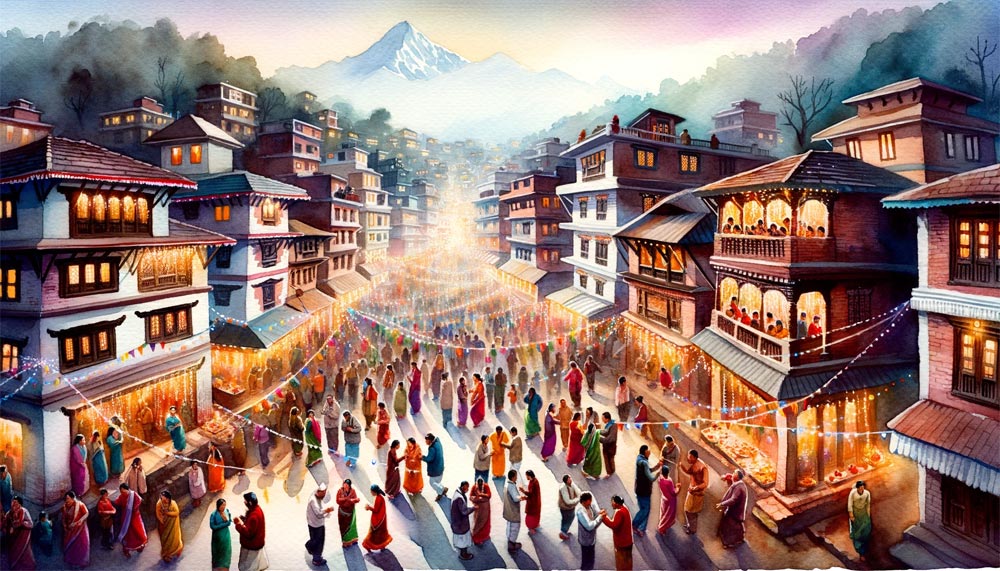
1. Birth and Childhood Rituals
Pasni:
Traditionally known as the 'rice feeding ceremony', Pasni marks an infant's introduction to solid foods. Typically celebrated when the baby is six months old for boys and five months for girls, it's an event where the child is dressed in traditional attire and fed rice pudding by family elders.
Nwaran:
This is the naming ceremony held on the 11th day after birth for boys and on the 9th day for girls. The child's name, derived from astrological readings, is whispered into their ear amidst Vedic chants.
2. Coming of Age Ceremonies
Bratabandha:
A vital rite of passage for Brahmin and Chhetri boys, the Bratabandha signifies their transition into manhood. This ceremony involves the wearing of the ‘janai’ or the sacred thread, symbolizing their readiness to bear responsibilities.
Gufa Rakhne:
For Newar girls, the 'Gufa Rakhne' or 'Gufa ritual' marks their passage into womanhood. This tradition involves the girl staying in a darkened room for up to 12 days, symbolizing her transition from childhood to adolescence.
3. Marriage Ceremonies
Swyambar:
At the heart of the Nepali wedding rituals, Swyambar involves the exchange of garlands and vows between the bride and the groom. Following this, the couple circles the holy fire, cementing their bond.
Janti:
This vibrant ritual witnesses a procession that accompanies the groom to the bride's residence, with traditional music, dance, and jubilation setting the mood.
4. Death and Mourning Customs
Upon the demise of an individual, a series of rituals are undertaken:
13-day mourning period:
During this time, close family members of the deceased avoid partaking in celebrations and often stay at home, recollecting the memories of the departed soul. Ritual purification ceremonies are conducted throughout this period.
Shradha:
Conducted annually, this ceremony pays homage to deceased ancestors, ensuring their souls rest in peace and seeking their blessings for the family's well-being.
5. Festive Gatherings
Numerous festivals dot the Nepali calendar, and families come together to celebrate them:
Dashain:
Nepal's most significant festival, Dashain sees families reuniting, with elders applying ‘tika’ (a mixture of yogurt, rice, and vermilion) on the foreheads of younger members, blessing them.
Tihar:
Similar to Diwali in India, Tihar is a festival of lights where families worship animals like crows, dogs, and cows, and also the Goddess Laxmi, seeking prosperity.
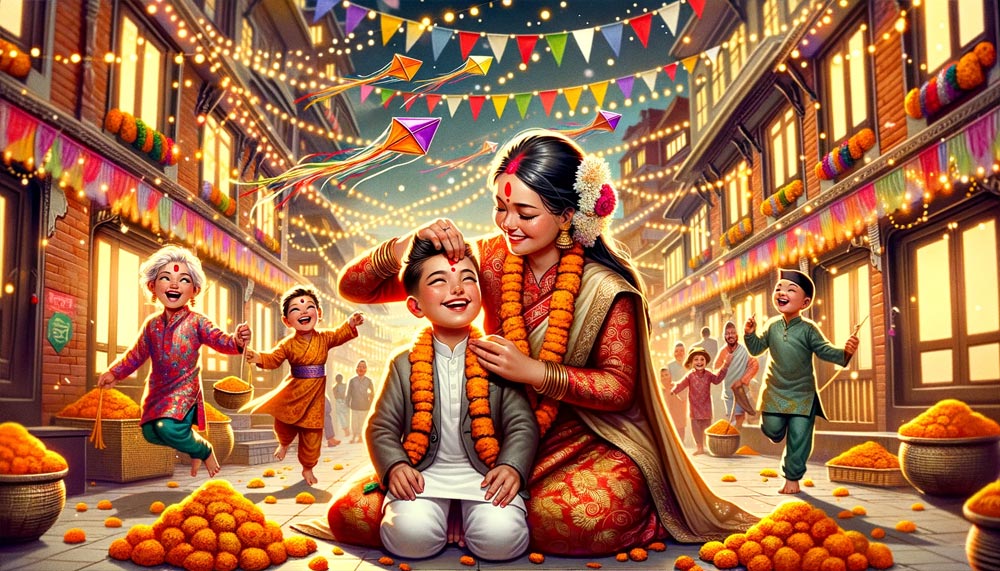
Teej: The Festival of Women
Teej is predominantly a women's festival, marked by fasting, dancing, and singing. Married women fast and pray for the well-being and longevity of their husbands, while unmarried women seek blessings for a good spouse. Women dress in red saris, symbolic of marital bliss, and visit temples, particularly the Pashupatinath Temple in Kathmandu.
Indra Jatra: Celebrating Rain and Harvest
Indra Jatra is an eight-day traditional street festival in Kathmandu celebrating both the god Indra and the recent harvest. The Kathmandu Durbar Square teems with people witnessing chariot processions, mask dances, and the raising of the lingo (a ceremonial pole). Another highlight is the Kumari Jatra, a procession featuring the living goddess Kumari.
Maghe Sankranti: Welcoming Warmer Days
Maghe Sankranti is celebrated as the winter solstice, marking the increase in daylight. It’s a festival that celebrates the end of the winter chill. Families come together to share feasts that include sesame seed balls, molasses, yam, and spinach, all believed to purify the body.
Holi: The Festival of Colors
Although celebrated across many parts of South Asia, Holi in Nepal has its unique flavor. Families, friends, and communities come together, smearing each other with colored powders, drenching with water balloons, and reveling in the festivities. It's a celebration of the victory of good over evil and also ushers in the spring season.
Janai Purnima: The Sacred Thread Festival
Janai Purnima (or Raksha Bandhan) sees Brahmin and Chhetri men renewing their Janai, the sacred thread worn across their chests. Additionally, people from various communities tie a protective thread around their wrists, believed to ward off evils. Families cook a special dish called 'Kwati', a soup made from nine different beans, symbolizing unity in diversity.
Buddha Purnima: Celebrating the Enlightened One
This festival marks the birth, enlightenment, and death of Lord Buddha. Lumbini, the birthplace of Buddha in Nepal, becomes the focal point of celebrations. Families visit monasteries, light lamps, and pray, commemorating the teachings of peace and non-violence.
Yomari Punhi: The Newari Rice Delicacy Festival
Yomari Punhi is a unique festival celebrated by the Newar community of the Kathmandu Valley. Families come together to prepare 'Yomari', a confection of rice flour dough filled with molasses and sesame seeds, which is then steamed. It’s not just about the delicacy, but also a celebration of the rice harvest.
In Nepal, every festival is an affirmation of family values, ancestral traditions, and societal bonds. These gatherings offer a momentary pause from the humdrum of daily life, allowing families to reconnect, rejuvenate, and collectively partake in traditions passed down through generations.
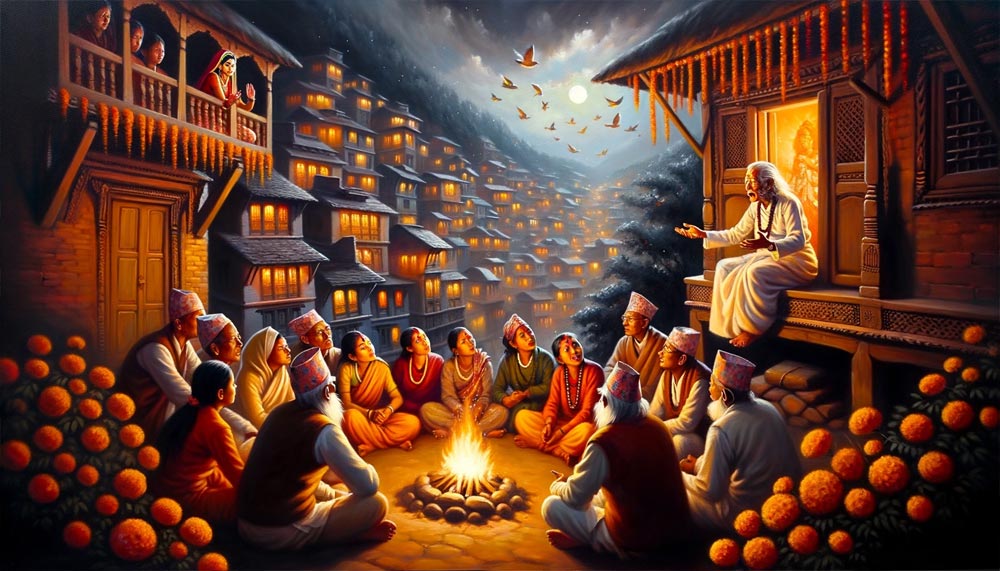
The Resounding Psychological and Sociological Benefits of Nepali Family Rituals and Traditions
Nepal, with its rich tapestry of customs and ceremonies, offers not just a cultural spectacle but has embedded within its traditions profound psychological and sociological benefits. The deep-rooted family rituals have a far-reaching impact, influencing the mental, emotional, and social well-being of individuals and the larger community. Let's delve into the science and sociology behind these benefits.
1. Psychological Benefits
Emotional Anchoring:
- Consistency and Stability: Rituals like Dashain or Teej, celebrated annually, provide consistency and predictability in an otherwise chaotic life, making individuals feel grounded.
- Identity and Belonging: Celebrations like the Bratabandha or Gufa Rakhne give individuals a sense of identity, linking them to their ancestors and providing a cultural backdrop to their existence.
Positive Reinforcement:
- Stress Reduction: Participating in family gatherings, especially during festivals, alleviates stress. A case study conducted in 2018 on elderly Nepali citizens found that those who actively partook in family festivals displayed lower signs of anxiety and depression.
- Sense of Accomplishment: Completing rituals, be it fasting during Teej or cooking traditional dishes during Maghe Sankranti, gives individuals a sense of accomplishment and boosts self-worth.
Memory and Cognitive Benefits:
- Memory Preservation: Rituals aid in preserving familial memories. Anecdotes shared during gatherings get etched into the minds of younger members, ensuring that family tales and legacies continue.
- Enhanced Cognitive Function: Engaging in ritualistic activities, like the intricate processes during Janai Purnima, can stimulate cognitive functions, enhancing concentration and attention to detail.
2. Sociological Benefits
Community Building and Social Ties:
- Strengthening Bonds: Rituals necessitate familial gatherings. Be it the collective dances during Indra Jatra or family reunions during Dashain, such events fortify family ties and foster sibling camaraderie.
- Networking: Festivals act as social platforms, enabling individuals to expand their social circles, essential for personal and professional growth.
Value Impartation and Nation-building:
- Passing Down Morals: Rituals are not just practices but are imbued with values. By adhering to the customs of Teej, younger generations learn about sacrifice, love, and marital commitment.
- National Unity: Rituals, especially those celebrated across Nepal like Buddha Purnima, act as unifiers. Despite diverse ethnic backgrounds, people come together, fostering a sense of national pride and unity.
Economic and Societal Advancements:
- Boosting Local Economies: Festivals and rituals contribute to economic activities. The demand for traditional attire during Holi or local delicacies during Yomari Punhi supports local artisans and businesses.
- Gender and Social Roles: Rituals subtly delineate societal roles. While some critics argue they reinforce gender stereotypes, rituals have evolved. Women, in modern Nepal, are not just participants but also decision-makers, evident in their roles during Teej or Dashain celebrations.
Dr. Anjana Rai, an anthropologist who has extensively studied Nepali culture, remarks, "Family traditions in Nepal are not mere ceremonies. They are interwoven with the psyche of the people, acting as therapeutic outlets, moral compasses, and societal pillars." Her studies, along with numerous other sociological and psychological explorations, underscore the multifaceted benefits of these rituals.
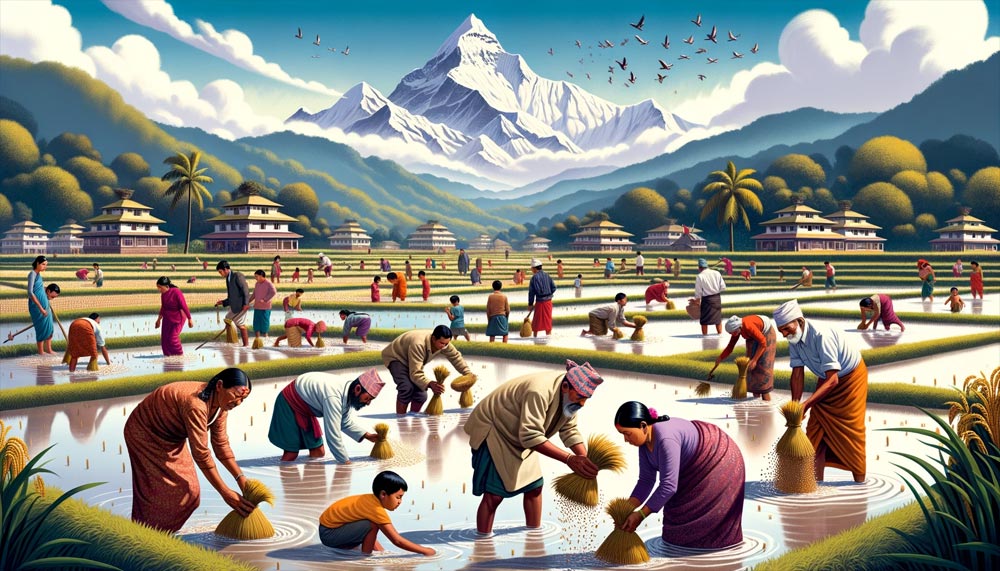
Evolution of Family Traditions in Modern Nepal
In a globalized world where cultures merge and traditions evolve, Nepal remains a cornerstone of rich heritage. Yet, like all societies, Nepali traditions too are in a state of flux, adapting to the demands of modernity while seeking to preserve their ancient essence. The evolution of family traditions in contemporary Nepal paints a tapestry of change, adaptation, and resilience.
1. Urbanization and Migration
Shift from Joint to Nuclear Families:
- While traditionally, Nepali families thrived in joint setups, urbanization has seen a shift towards nuclear family structures. This has slightly altered the dynamics of family gatherings, making them less frequent but possibly more intimate.
- The migration of youth to cities within Nepal and abroad for employment or education has meant that family rituals are sometimes celebrated without the complete family. This absence has given rise to virtual celebrations, where families connect via video calls to participate in rituals.
2. Digital Influence and Modernization
Digital Documentation:
- Previously, stories and traditions were orally passed down through generations. Now, with the rise of smartphones and social media, families document festivals and rituals, creating digital archives accessible to future generations.
Online Shopping:
- Preparation for festivals like Dashain or Tihar traditionally involved bustling local markets. Today, the convenience of online shopping has seen a surge in families buying ritualistic items, gifts, and attire online.
3. Evolving Gender Roles
Increased Participation:
- Traditions like Teej, once women-centric, have seen increased participation from men, reflecting changing gender dynamics. Men are becoming more involved, supporting and sometimes even joining in the fasts and dances.
Equal Decision-making:
- In modern Nepal, women are not just participants but also decision-makers. In family rituals and gatherings, their voices are given equal importance, reflecting the nation's strides towards gender equality.
4. Interpretative Traditions
Understanding Over Blind Faith:
- Younger generations, exposed to global viewpoints, seek to understand the logic behind traditions. Instead of following rituals blindly, many families now discuss the significance behind them, leading to a deeper appreciation.
Adaptation to Contemporary Needs:
- Some rituals have been modified to align with modern lifestyles. For instance, the timings of certain rituals, previously strictly adhered to, now accommodate the hectic schedules of working family members.
5. Balancing Tradition with Modern Values
Inclusive Celebrations:
- While Nepal has always celebrated its diversity, modern Nepali families are increasingly inclusive. Festivals of one community are often celebrated by members of another, fostering unity in diversity.
Environmentally Conscious Rituals:
- With growing environmental awareness, families are adapting eco-friendly means. Traditional lamps during Tihar are now often replaced with energy-saving lights.
6. Return to Roots
Reviving Lost Traditions:
- Interestingly, with global exposure, there’s been a trend among the Nepali youth to reconnect with their roots. Families, especially those living abroad or in urban setups, are increasingly reviving old traditions, recognizing their significance in identity formation.
Strengthening Community Ties and Nation-Building: The Power of Nepali Family Traditions
Nepal, characterized by its diverse ethnic groups and varied topography, holds a secret to its united identity – its deep-rooted family traditions. These traditions, passed down generations, not only act as the glue binding individual families but play an instrumental role in strengthening community ties and nation-building. This article delves into how these rituals and customs contribute to forging a cohesive Nepali society.
1. Catalysts for Community Interaction
Shared Celebrations:
- Festivals like Dashain, Tihar, and Holi are not limited to individual families. They spill onto the streets, with entire communities coming together. These shared celebrations act as melting pots, breaking barriers of caste, creed, and economic status.
Joint Rituals:
- Certain rituals, like the Ropain (rice planting festival), necessitate collective participation. Neighbors and community members collaborate, turning individual acts into collective endeavors, fostering camaraderie and mutual trust.
2. Reinforcing Shared Values
Moral Foundations:
- Many rituals serve as conduits to pass down shared societal values. Festivals like Teej, which emphasize marital fidelity and familial bonds, lay down the moral fabric of society.
Unity in Diversity:
- Despite the plethora of tribes and ethnicities in Nepal, shared traditions like celebrating Buddha Purnima or the reverence for Mount Everest, act as unifiers, reminding citizens of their shared heritage and mutual respect.
3. Economic Synergy through Traditions
Boosting Local Trade:
- Rituals and festivals stimulate economic activities. Whether it's the sale of marigold flowers during Tihar or traditional foods during Maghe Sankranti, such customs support local artisans and traders, creating economic interdependence.
Tourism and Global Appeal:
- Unique traditions, like the Indra Jatra or the Kumari worship, attract global tourists. This not only boosts the nation’s economy but fosters a sense of pride among Nepali citizens.
4. Strengthening Intergenerational Bonds
Bridging the Age Gap:
- Rituals often necessitate the involvement of both the young and old. The elderly pass down stories, legends, and the significance of rituals to the younger generation, ensuring continuity and a shared sense of history.
5. Fostering National Identity and Pride
Shared Cultural Symbols:
- Icons like the Kumari (living goddess) or rituals like the New Year's Bisket Jatra are recognized across Nepal. These shared symbols foster a sense of national identity and pride.
Cultural Diplomacy:
- Family traditions, when showcased on international platforms or during diplomatic exchanges, not only highlight Nepal's rich heritage but play a role in its soft diplomacy, carving its identity on the global stage.
Personal Narratives: The Heartbeat of Traditions
Manisha, a third-generation Nepali immigrant in the US, emphasizes the importance of family traditions in Nepali culture. "Even thousands of miles away from Nepal, we diligently follow our rituals. It's our way of staying connected to our roots, and it provides a sense of continuity for our children."
Similarly, Keshav, a school teacher in Pokhara, speaks about the impact of Nepali family customs on societal bonds: "Whenever there's a wedding in our community, the entire village gets involved. It's not just a union of two individuals, but a collective celebration."
Conclusion: The Everlasting Essence of Nepali Family Traditions
In the rapidly evolving world, where change is the only constant, the family rituals and traditions of Nepal stand as a testament to the resilience and adaptability of a culture. Whether one examines their influence on child development, their contribution to societal bonds, or the sheer joy they bring, their significance is undeniable.
By valuing and preserving these traditions, not only do we pay homage to our rich Nepalese heritage, but we also ensure that future generations are privy to the wisdom, warmth, and unity these rituals encapsulate.
Nepal Related Topics Culture

